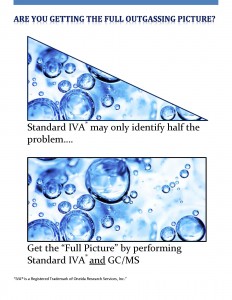RGA Testing
INTERNAL GAS ANALYSIS OF SEALED PACKAGES
Oneida Research Services offers a number of residual gas analysis testing methods, also known as RGA testing or IGA testing, including Mil-Std 883 method 1018 and Mil-Std 750 method 1018 Internal Gas Analysis testing for use in air-tight sealed or hermetic Package Gas Analysis projects. ORS is DLA approved for these RGA testing methods.
The analysis and identification of gaseous components within a hermetic package cavity using RGA testing equipment can be very useful when testing new product designs or performing quality control work on an existing product. ORS offers a number of residual gas analysis testing methods for use in Package Gas Analysis projects, in order to accurately test for these gases.
RGA Testing Methods
Internal Vapor Analysis (IVA®) is used to quantitatively measure the primary and trace gases inside air-tight or hermetic components. The gas content inside sealed components, particularly moisture concentration, can cause long-term reliability problems such as corrosion, fogging, leakage, current bit errors and lubrication issues. Known to some as Residual Gas Analysis, RGA testing, IGA testing or Mil-Std 883 method 1018 (Internal Gas Analysis – IGA testing), Internal Gas Analysis testing measures the primary sealing gases and trace gases inside a component. It is ideally suited for process development, sealing quality control, studying long-term outgassing of the enclosed materials inside the components, and for product qualification. Epoxy sealed packages, welded packages, and solder sealed packages can be analyzed for internal gas content.
High-Resolution IVA (HR-IVA®) services using our HR-IVA® Analyzer for testing cavity gases in very small volume packages. Also known as micro-RGA testing, this new technology provides tremendous sensitivity to package volumes as small as 1 nanoliter compared to standard Quadrupole techniques which are only applicable to samples larger than 0.02 cc. This technique is DLA (Defense Logistics Agency) suitable to Mil-Std 883 method 1018 and Mil-Std 750 method 1018 for volumes as small at 0.0003cc (300 nanoliters). Vacuum sealed packages, MEMS devices and UB style packages are typical samples tested for internal gas content.
Gas Cylinder Analysis. Oneida Research Services can provide RGA gas analysis testing for representative samples of sealing and process gases. Monitoring the process stream gas and dry box atmosphere with advanced RGA equipment is essential for benchmarking initial sealing conditions.
Organic Mass Spectrometry. services at ORS provide method development and mass spectrometry testing services to a variety of industries. GC/MS analysis can be performed on a variety of sample matrices via Static Headspace, IVA® of hermetic devices, solvent extraction and direct injection, direct air injection, residual solvent analysis, gas cylinder analysis, and analysis of samples placed in ampules. Testing is qualitative, semi-quantitative, and can be customized to suit your RGA analysis needs.
Getter Sorption Testing (also known as Delta-P Testing) is used on getter materials to provide safer operational environments for the cryogenic, nuclear, aerospace and defense industries. Hydrogen getters eliminate failures in microelectronics, cryogenics and energy storage systems. A getter is typically a reactive material that is placed inside a closed system to maintain a vacuum or other desired gas composition through adsorption and absorption. This process of removing residual gas in this way is known as gettering.




